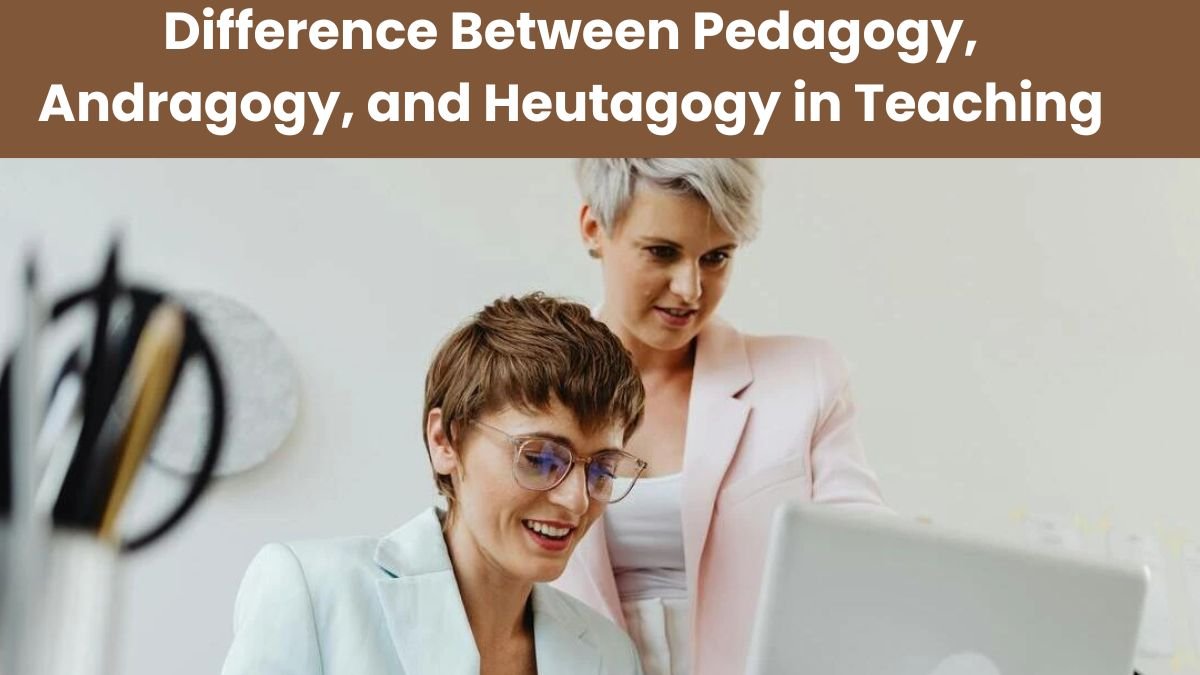Education is not just a means of imparting knowledge, but it is a deeply intertwined process of learning and teaching, in which many factors such as the age, experience, self-efficacy and motivation of the learners play an important role. Keeping these aspects in mind, three major teaching approaches emerge – Pedagogy, Andragogy and Heutagogy. All three are important in their own place in the world of teaching and are used according to the needs of the learners.
In this article, we will understand in detail what these three approaches are, what are their characteristics, and when and how we should adopt them as a teacher or trainer.
Pedagogy: Traditional Style of Education for Children
The word pedagogy comes from the Greek language, which literally means “leading the children.” It is a method in which the teacher completely guides the learner. This style is commonly used in the education of children in schools, where the teacher decides what to teach, how to teach and when to teach.
Key features:
- Dependence: Students are completely dependent on the teacher.
- Objective of learning: To move to the next class as per the syllabus.
- Teaching resources: Dependence on material prepared by the teacher.
- Motivation: External motivation – like parents, teachers, competition etc.
- Teacher’s role: Guide, who imparts knowledge and maintains control.
- Example: While teaching mathematics in school, the teacher first explains the concept, then gives questions and then gives homework – this represents the pedagogical style.
Andragogy: Modern concept of adult education
The term andragogy was first introduced by Malcolm Knowles for the education of adults. This approach assumes that adult learners are self-sufficient, have life experiences and they learn when they feel the need.
Key features:
- Autonomy: Adult learners are self-directed.
- Use of experience: Learn from own and others’ life experiences.
- Learning purpose: Improve performance or as needed.
- Motivation: Intrinsic motivation – self-esteem, confidence, recognition etc.
- Teacher’s role: Supportive and guide, who creates an environment of cooperation and respect.
- Example: Training programs involving employees to learn new technology or software to improve their job performance are based on the principles of andragogy.
Heutagogy: Learning you do when you want to
Heutagogy is regarded as the highest level of education that is known as the art of self-definite education. This is one of the needs of the 21st century, more so in the digital world whereby learning no longer happens in the classroom.
Features:
- Self-directed: The student chooses which what, when and how to learn.
- Experience and reflection: Learning in own experiences, reflection, scanning the environment.
- Objective: It is learning to be creative and innovative, rather than problem solving.
- Motivation: Self-async, artistic singularity, self capability and teamwork.
- Teacher: Capacity builder- the one who assists in the learning process.
- Example: The students enrolled in online courses, who select material based on what interests them, self-regulated their learning speed, and who make self-assessment, pursue the heutagogical approach.
Comparison Table: Differences in a Glance
| Characteristic | Pedagogy | Andragogy | Heutagogy |
|---|---|---|---|
| Learner | Dependent child | Self-directed adult | Self-motivated learner |
| Role of Teacher | Controller and director | Facilitator and guide | Capability developer |
| Reason for Learning | To advance to the next grade | Need for improved performance | Desire to learn from new experiences |
| Motivation | External (marks, rewards, competition) | Internal (respect, self-confidence) | Self-motivation, creativity, self-efficacy |
| Control Over Content | Teacher decides | Decided collaboratively | Learner decides |
| Approach | Subject-centered | Task or problem-centered | Experience-based, creativity-centered |
Application to Teachers
A good teacher in the current teaching situation is the one that is knowledgeable of the three approaches and is capable of modifying them according to the necessity. Although the traditional pedagogical methods can be applicable to learners in the schools, the andragogy has greater applications in training adult learners. It is important that we have to embrace heutagogy in this technologized autonomous age.
Conclusion
Pedagogy, andragogy and heutagogy – these three are not just words, but reflect the depth and breadth of teaching. As the form of education is changing, teachers and educational institutions also need to understand and adopt these three methods A successful teacher is one who knows when to ‘give knowledge’, when to ‘guide’ and when to ‘inspire self-learning’. This is the key to a holistic, humane and effective education.
